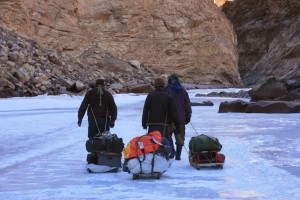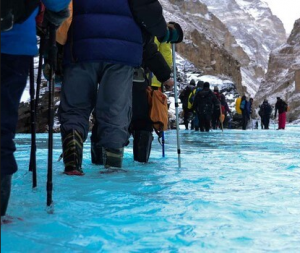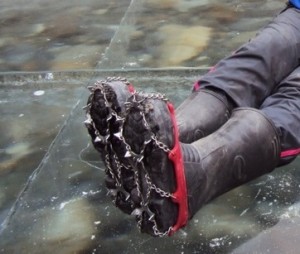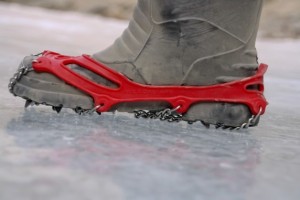One of the most common questions asked by a traveler prior the trek that -How to walk on Chadar trek ? Or what shoe should I use during the Chadar trek? What is penguin style? And much more.
One of the most unique and magnificent treks of the world, the Zanskar canyon trek, mostly known as Chadar Trek is hugely popular now. Chadar (literal meaning is Blanket in the Hindi language) signifies the frozen sheet of ice that is formed on the raging River Zanskar. Due to extreme cold and the less amount of direct sunlight as the river flows through a narrow gorge. Solid ice is formed best around the time frame, 2nd week of January to 2nd week of February – the time when the winter at it’s maximum.
One of the most common questions asked by a traveler prior the trek that -How to walk on the hard ice of Chadar ? Or what shoe should I use during the Chadar trek? And much more.
Let’s start in this way.
Do I need to walk on entirely hard ice?
Formation of Chadar is not exactly identical every year and Chadar Trek does not offer you to walk on hard ice throughout 100% of the trail. Due to an inconsistent formation of Chadar, some patches you will walk on water OR you need to climb up through rock & traverses a little distance on loose or hard soil and again connect back to the frozen river. This phenomenon is more frequent in last few years. So we can segregate in 3 varieties of terrain to take care during the trek;
- Rocky and dusty soil of trans-Himalaya 10-15%
- Hard thick ice sheet, the chadar 75-60%
- Semi-hard ice or watery river part. 15-25%
- Rocky & dusty terrain
- Hard ice sheet the Chadar
- ice & watery terrain
Negotiating rocky & dusty soil of trans- Himalaya:
Where ever you trek on trans-Himalaya you will be offered with rugged terrain with rock & dust. Zanskar Canyon is not an exception of it. These rain shadows of Himalaya doesn’t grow big trees in vegetation to root the soil. Any good trekking shoes with a deeper indentation (lug pattern) sole made of enough flexible rubber generate good traction to offer a nice grip in this terrain. ‘Vibram’ sole is one of the best in class. Since Chadar doesn’t offer you a very stiff & continuous up or down inclination, this part of the terrain is least tricky.
The Penguin style, walk technique on hard ice:
if you are walking Chadar with RockyFeet where a micro spike or walking crampon is provided OR in case you are using your own then you don’t need to follow the penguine style on hard ice. Walk on your own way and just enjoy the natue more.
There is a well-known technique called Penguin style followed all over the world to walk on hard ice. As the name suggests, we have learned it from the bird Penguin. The way they maintain their balance on hard ice of Antarctica. We tried to put in a nutshell of 12 steps;
Balance the CG -Centre of gravity
1. Keep your body weight on forwarding step.
The main trick is to adjust your CG and use your body weight to create a firm grip on each step. The following pictograph will help you to understand in detail
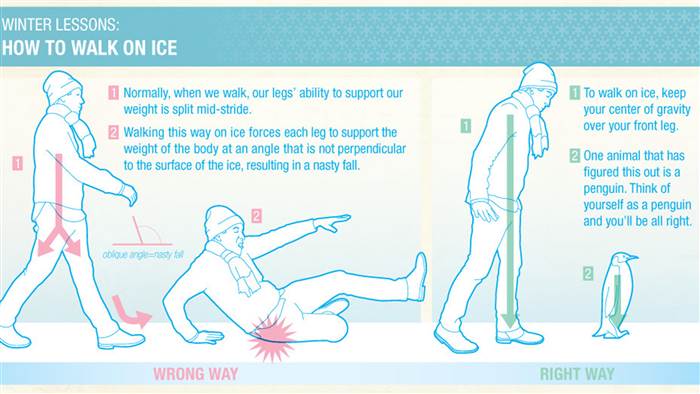
2.Keep your knees a little loose
let them bend a bit. This will keep your center of gravity lower to the ground, which further stabilizes the body.
3.Point feet slightly outside
Spread your feet out slightly, to increase your center of gravity.
4.Useful hands
The human body has a natural instinct to adjust the CG or balance by spreading hands both side at the time of slippage. So don’t forget to use it and keep your hands free for that; not in the pocket due to cold.

5.Take short steps slowly or shuffle
Once you are properly balanced with one forward step then slowly take the next small step to shuffle your CG again on the other foot. Moving in small and slow step will keep the momentum minimum and help you to react to changes of grip.

6.Use a trekking pole
A trekking pole has major 2 utilities to serve at Chadar.
- Use one or even a pair of trekking poles to help with balance. You can use the tip to get an extra good grip on the ground. Make sure they’re at the right height for you. When your pole is held upside down, the end should be at wrist level.
- You can use it to check the firmness of ice or depth of snow in route before you step. A snow basket at the tip will be a nice addition.

7. Keep your backpack light
Carrying heavy load on ice need more practice as it spoils your balance. So keep your backpack light. Pack wise with only necessary things and if it goes more with your gears, hire a porter to share the load. Even local people from Zanskar use a sledge to carry a heavy load.
The game of traction :
8.Use Lug pattern sole shoes
Avoid flat sole & high or pointed hill shoes. Any good shoes with a deeper indentation (lug pattern) sole made of semi-flexible/ semi-hard rubber generate good traction to offer a nice grip.
9. Walk flat footed
Don’t move on toe or hill. Use your complete foot surface to step. More surface area generates more frictions and protects you from slipping. So try to make the step by placing your whole foot down at once.
10.Use a walking crampon to generate further traction.
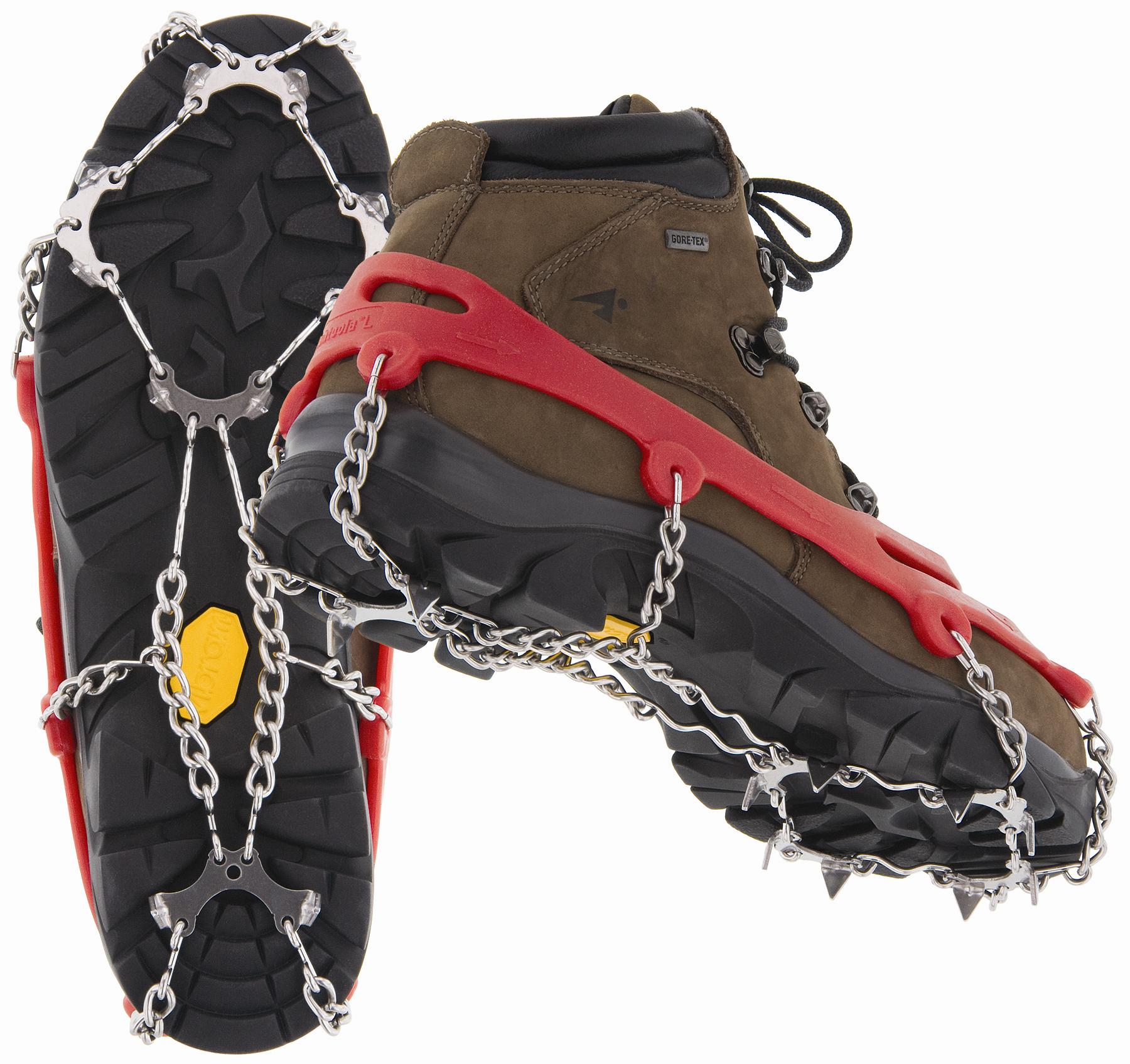
The gear used to get a grip on ice called crampon. The word Crampon in dictionary describes a metal plate with spikes fixed to a boot for walking on ice. The metal teeth of it create bite on ice to generate great traction.For Chadar trek a grade C1 walking crampon is good enough which fits with a decent trekking shoe with semi-stiffness. Sometimes it is referred as micro spike by product category. This gear can really help to walk Chadar with more confidence and take care of lot of your mistake you make on penguin style as it is newly introduced.But be careful! crampons become dangerously slippery and must be removed before walking on smooth surfaces such as stone.
Remember if you are using walking crampon then no need to follow the penguin style dragging or shuffling your feet. You can almost walk with your normal walking style. A little hard stepping will help you to catch the grip firm and all above tips of balance will make you more stable on move.
Read more on Walking crampons.
Safety Measures
If you fall backward, make an effort to tuck your chin. So your head doesn’t hit the ground first. Some slippage may obvious on a 1st go. if you fall, while falling keep your muscles relaxed, don’t resist with stiff muscles, otherwise, cramp or pull in muscle might occur. Finally get up, smile & shine.
12.Use a Helmet
Use of a helmet is wise at Chadar to avoid head injuries. This makes your life safe to a large extend.

How good to use a gumboot at Chadar?
There are a lot of travel operators (majorly locals) promote – “Chadar is best to do with rubber Gumboot” as people of Zanskar are doing it in that way from last 100 years.
Good part of the idea:
- Gumboot is a shoe to cross water. A median high or up to knee level gumboot is an appropriate shoe to manage the semi-hard ice-watery part of Chadar trail. It protects you from getting wet even if your feet go into the river water. So in that way, gumboot is a must for Chadar. You can use gaiter too for double protection.
- If you wear a pair of walking crampon on top of gumboot this works well for hard ice too. Just gumboot is not good for hard ice. And remaining 10-15% of rocky or dusty terrain also can be managed by removing crampon from Gumboot. It does not offer a great grip but it is manageable.
- If you are already owning a pair of perfectly fit trekking shoes, you might face problem to wear it with extra socks or woolen socks. Someone may prefer to use it during day time walking too. While buying a Gumboot for Chadar at Leh, you may try it with extra socks and go for the size accordingly.
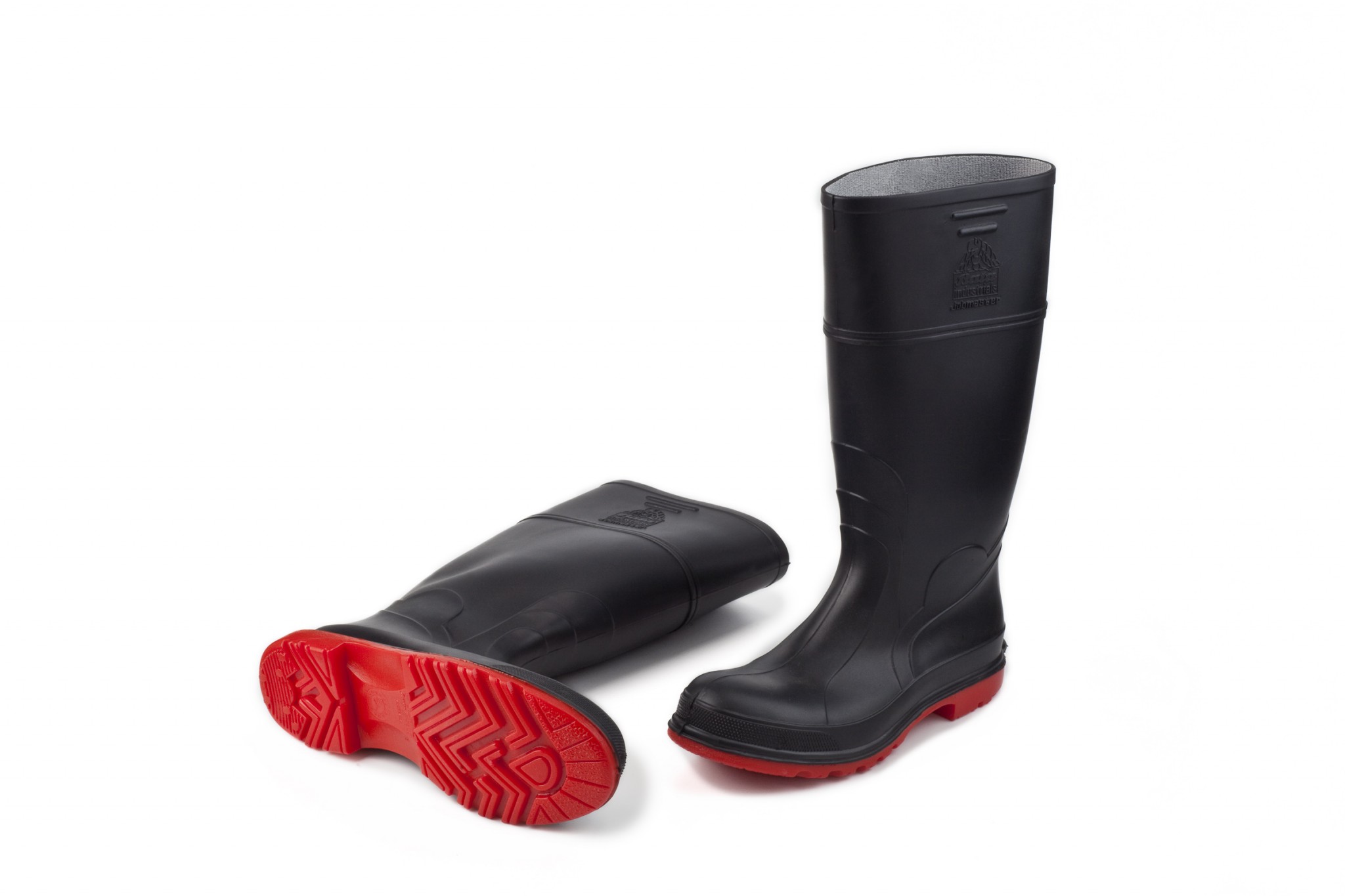
image © 2011 University of Sydney / Jamie Williams
Bad part of the idea:
- Just wearing gumboot on hard ice do not provide better grip than wearing walking crampon. The gumboots are meant to be put on only during water crossings. They aren’t ideal for ice surfaces and impair motion. Where more than 60% of the trail is hard ice, the suggestion of wearing just a gumboot throughout the chadar trek is a cost saving propaganda from travel operators. I believe even people from Zanskar will prefer to have a crampon if they can afford it. Don’t forget that science of adventure sports and outdoor gears have gone through a long journey of design evolution to assure more safety. So not taking the advantages of the gear & science we have developed till today, is as equivalent to use bow and arrow on the battlefield in mid twenty1st centuries.
- Gumboots are made of hard rubber or plastic which gets harder with freezing cold of Chadar and flexibility tends to zero. They are a little painful if you wear them for a very long time.
- If you have a bigger shoe size you may face problem to get it from Leh market. Inform early to your local contact person to fetch it for you.
I am confused, finally what shoe should I use on Chadar?
- I am definitely recommending for Gumboot with walking crampon/ micro spikes considering gumboot is a must for Zanskar river water crossing at broken Chadar. It will save time to change shoe on the continuous overlapping terrain of water and ice of river which covers most of the trail .
- Also, as you don’t have the practice to walk with gumboot for long, keep a good hiking shoe for reinforcement or relaxing your feet . The solution may cause you to carry a little more weight but at the extreme adventure of The Chadar Trek you should be prepared enough.
image copyright @ Ashutosh Kumar


